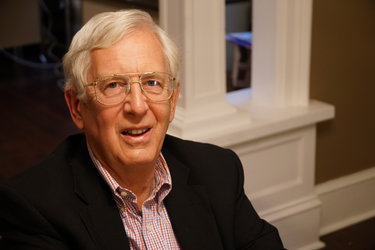‘Go back to the source,’ urges historian Bruce Dearstyne
GUILDERLAND — Historian Bruce Dearstyne has just published a book he hopes will be judged.
“The Crucible of Public Policy: New York Courts in the Progressive Era,” his latest book published by the State University of New York Press, examines cases heard by the state’s top court, the Court of Appeals, which Dearstyne posits was arguably the second most important in the nation, behind the United States Supreme Court.
In the early part of the 20th Century, the Court of Appeals served as a place of test or trial where forces interacted to cause change — a crucible.
Dearstyne’s book shows how the high court mediated among the competing rights of the legislature to regulate through laws, of business owners to manage their businesses without government interference, and of individual New Yorkers to exercise personal liberty.
What he strove to do in his book, Dearstyne says in the week’s Enterprise podcast, is “to present the evidence and say to people … read the decisions for yourself.”
“I would say they have something of an obligation to do it,” said Dearstyne. Too much these days, he says, what we learn is filtered through what other people think and say.
“Go back to the source,” Dearstyne urges. “Read for yourself.”
In the same vein, he urges New Yorkers to read their own state constitution, written in 1777, just as they should read the United States Constitution, adopted in 1787 — with parallel themes to New York’s.
“People seldom sit down and read the United State’s Constitution,” says Dearstyne, noting it’s not that long; neither is the 1777 state constitution at about 5,000 words.
New York’s constitution starts by quoting the Declaration of Independence. Both documents build in safeguards against tyranny but also say to individuals: “Here’s how we’re going to live together. Here’s the rules of the road. You know, the guardrails. You’ve got to stay in these. If you get outside of them, you’re going to have trouble … Or the court’s going to head back in.”
Dearstyne hopes his book will engender empathy for the courts.
These days, Dearstyne believes, people are programmed to have a short historical memory and many don’t find history exciting.
For Dearstyne, it’s riveting.
“It’s about people. It’s about cause-and-effect relationships,” he says of history. “It’s about things that really count.”
Dearstyne, who grew up on a farm in Berne, surrounded by history, revered his teachers at Berne-Knox. He was the first in his family to go to college, studying history at Hartwick College in Oneonta.
There, he wrote his senior thesis on Alton B. Parker, New York’s Progressive Era judge, defeated in his 1904 presidential run against Theodore Roosevelt. A chapter in “The Crucible” is devoted to that run.
Dearstyne went on to get his Ph.D. in history from Syracuse University and has taught history at the University of Maryland, the University at Albany, and at Russell Sage College. He spent the bulk of his career as the program director of the New York State Archives and relishes doing research with original documents.
In researching “The Crucible,” Dearstyne used the Court of Appeals archival records, most of which hadn’t been used before. That way, he could see what the judges had in front of them when they made their decisions. This includes briefs from both public authorities defending the laws and complainants’ attorneys challenging the laws.
The Progressive Era, from about 1900 to 1920, is Dearstyne’s favorite. He sees it as “a time of reckoning.”
“A lot of issues and problems built up in the late 19th Century relating to organization, industrialization, and the large number of immigrants coming in,” says Dearstyne. There was a sense in the country that a lot of these built-up issues hadn’t been addressed.
Dearstyne defines three groups pushing for progress on the issues: editorialists and journalists doing investigative work, disparagingly called “muckrakers” by Theodore Roosevelt; middle-class professionals, including many women, pushing for reform; and political leaders such as Roosevelt, Woodrow Wilson, Charles Evans, and Al Smith.
“They didn’t have a unified, seamless, unassailable agenda,” says Dearstyne. “But in general they knew that they wanted to restore integrity in politics and make government more responsive to the public. And so they fought political bosses … they regulated corporations … they protected workers.”
The era embodied a commitment to community as well as mutuality and compromise while trying to ward off extremists, said Dearstyne.
As new reforms were challenged in court, New York’s Court of Appeals became a crucible, looked to by other states, said Dearstyne.
The decisions rarely follow a straight path as legislation, federal rulings, and the prevailing social views led to changes. Dearstyne devotes five chapters of his book to workers’ rights and protections.
In 1904, the Court of Appeals upheld a first-of-its-kind New York law to protect workers’ health by regulating hours and conditions of bakery workers. In 1905, the conservative United States Supreme Court, which leaned towards protecting businesses from government regulations, reversed the decision, declaring New York’s law unconstitutional. It took decades for the Supreme Court to embrace the more expansive view of government’s regulatory authority.
In 1910, New York passed the first worker compensation law in the United States, which the Court of Appeals struck down as revolutionary. This led to an amendment validating that authority, after which the Court of Appeals validated a new, stronger workers comp law.
Another chapter details a suit challenging the state’s requirements that children be vaccinated against smallpox in order to attend schools, which has parallels to today’s court challenges over COVID-19 requirements set by the state.
While the Progressive Era dealt with many of the changes wrought by industrialization, our current era is similarly dealing with the upheavals caused by the internet age.
Dearstyne cited a recent public opinion poll, showing 80 percent of Americans today believe the country is on the wrong path. In the Progressive Era, he said — noting there were no public-opinion polls then — “I think if they had and you would ask people in 1900, they would have said, ‘Well, the country is on the right path.’”
But many of the same issues that were decided in court cases in the Progressive Era are still issues today, he said, naming “personal privacy; public health; how far can the government go in regulating business; how far can the government go in either encouraging or restricting personal liberty on behalf of the people as a whole; how far should the government go in protecting workers and protecting women.”
Another parallel to modern times, he said, is the widespread sense of unease.
“I see in many ways nowadays, like those days, a period of stress, anxiety, a kind of worry, a sense we are drifting …. Things are kind of getting out of hand. And that we’ve let some things go too long. And what are we going to do about that?”
But in the Progressive Era, unlike today, Dearstyne said, “There was an inclination toward compromise, accommodation, bipartisan solutions. Politics stops at the water’s edge. Now,” he went on, “I think we all see overblown rhetoric, confrontational politics, not as much constructive debate over public issues as there ought to be, and lots of attention to and criticism about the Supreme Court in particular.”
While court criticism started over a century ago, Dearstyne said, “It was much more muted, constrained.”
He again returned to the advice to read court decisions — not just historic, but current decisions — readily available online. They are not just for the judges and lawyers, he says, but for the society at large.
“The courts,” says Dearstyne, “are supposed to be, in a sense, the representatives of the people. So read these decisions for yourself.”



